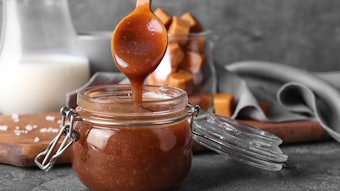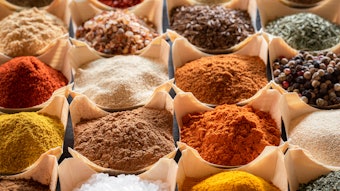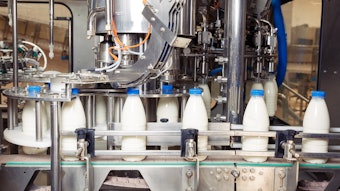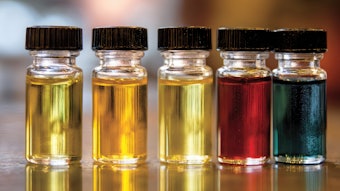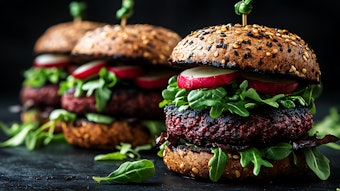
We all suffer from subtle biases and find it takes an act of will to include a flavor chemical we actually don’t like in a formulation. I have this bias against 6-methyl 5-hepten-2-one. I just don’t like it, and it is a struggle to add it even to flavors such as watermelon, where it is obviously useful. 6-Methyl 5-hepten-2-ol (FEMA# 4884, CAS# 1569-60-4) solves my problem. It has a faint family resemblance to the evil parent ketone but is superior in every respect, especially in watermelon flavors. The character is quite complex. It is first and foremost a soft green note. There are also clear links to apple and lemon characters. Behind all this is a subtle floral, almost lavender note. Nice to find another very interesting recent addition to the FEMA GRAS list, especially one that promises to enhance so many different flavor profiles.
Note that the dose rates given throughout this article are the levels suggested for use in flavors intended to be dosed at 0.05% in ready-to-drink beverages or in a simple bouillon.
Tropical Flavors
Guava: Just a touch, around 100 ppm, of this ingredient adds a little freshness and lift to many rather cloying guava flavors. Higher levels are attractive but less authentic.
Lychee: Most lychee flavors have a prominent, sometimes over-prominent, rose character. 6-Methyl 5-hepten-2-ol has a subtle effect within that rose element to freshen the floral note at quite a low level, around 20 ppm.
Pineapple: In pineapple flavors the effect of 6-methyl 5-hepten-2-ol is to add lift to the profile and freshen it. A good level in fresh pineapple flavors is 200 ppm.
Pomegranate: Pomegranate flavors are always interesting and challenging. A moderate addition of 6-methyl 5-hepten-2-ol, in the region of 100 ppm, gives added realism and freshness.
Watermelon: Most chemicals that have complex odors end up in a trade-off situation in many finished flavors. One odor note may be helpful but others may not. 6-Methyl 5-hepten-2-ol is such a perfect fit in watermelon flavors that all the aspects of its complex odor profile are helpful. The green note enhances freshness, the apple note fits in well to the overall profile, the lemon note works well with citral to improve consumer preference and the floral note deepens a flavor category that can often seem a little thin. A good starting point in watermelon flavors is 3,000 pm, but higher levels can be used in flavors that become more fantasy oriented.
Orchard Fruit Flavors
Apple: 6-Methyl 5-hepten-2-ol has quite a noticeable apple character and the level of addition depends very much on what you aim to achieve. For many apple flavors, 200 ppm is a conservative suggestion. If the objective is a very green apple profile, I suspect the sky’s the limit.
Apricot and Peach: The effect of this chemical is similar in both closely related flavors, adding freshness and lift. The ideal level in apricot flavors is, in my opinion, a little higher, 200 ppm. This compares with 100 ppm in peach flavors
Cherry: Cherry flavors also benefit from the addition of 200 ppm of 6-methyl 5-hepten-2-ol, more so in the case of authentic style flavors than benzaldehyde dominated horrors.
Berry Flavors
Raspberry and Blackberry: 6-Methyl 5-hepten-2-ol is especially interesting in raspberry and blackberry flavors because it makes a significant contribution to authenticity. The level of addition need only be moderate, 200 ppm in raspberry flavors and 150 ppm in blackberry flavors, but the effect is quite noticeable.
Strawberry: Not quite such a demonstrable effect in strawberry flavors but, nevertheless, this ingredient adds freshness at 50 ppm levels.
Citrus Flavors
Grapefruit: The level of addition of 6-methyl 5-hepten-2-ol to grapefruit flavors is very dependent on the profile you are trying to achieve. More peely flavors are better served by around 50 ppm, but higher levels, up to 200 ppm, can enhance grapefruit juice flavors.
Lemon: The complex character of his compound finds another very hospitable home in lemon flavors. At 2,000 ppm, it brightens and freshens lemon flavors and adds authenticity. Higher levels are also very pleasant, even if they drift a little away from the strictly natural profile of lemon.
Orange: The comments made about grapefruit flavors are equally applicable to orange flavors. Around 50 ppm helps peely flavors and 200 ppm is more appropriate for orange juice flavors.
Nut Flavors
Peanut: The addition of 6-methyl 5-hepten-2-ol to nut flavors seems illogical. It has no nutty character at all, but it does help to temper the dryness of the unsaturated ketones at around 50 ppm.
Hazlenut: This is also true for hazelnut and praline flavors, but the best level is a little more elevated, in the region of 100 ppm.
Walnut: Walnut flavors work best with the same 50 ppm level of 6-methyl 5-hepten-2-ol as peanut flavors, again helping mitigate the inherent dryness of the profile.
Dairy Flavors
Butter: There are some parallels in dairy flavors with the effect of 6-methyl 5-hepten-2-ol in nut flavors. In this category, it softens the harsh effects of the saturated cheesy ketones. A good starting level is 100 ppm.
Cheese: Cheese flavors vary dramatically. Probably the best level of addition for cheddar style flavors is 50 ppm but, obviously, higher levels in blue cheese flavors are very welcome.
Cream: Like butter flavors, cream flavors work best with just a subtle addition of this ingredient. An optimal level is 50 ppm.
Other Flavors
Coriander Leaf: The citrus character of 6-methyl 5-hepten-2-ol infers some similarity to cilantro and 500 ppm is a reasonable level to try in this minor flavor category.
Ginger: I suspect very few of us have attempted to create a truly synthetic ginger flavor. We rely instead on ginger oil or extract as a starting point. At 100 ppm of 6-methyl 5-hepten-2-ol, it adds freshness and brightness to oil-based ginger flavors.
Rose: Few rose flavors are based on genuine rose otto because of cost constraints. Attempting to create a good rose profile from individual ingredients is not so difficult but it suffers from the same issue as vanilla. Many trace ingredients make, together, a big impact on authenticity. 6-Methyl 5-hepten-2-ol is one such ingredient and is ideally added to rose flavors at 20 ppm.
Tea: This ingredient is custom made for green tea flavors. The level of addition is very dependent on the type of green tea but 300 ppm is a reasonable place to start. Black tea flavors are better served by lower levels, around 100 ppm.
Tomato: The comments made about 6-methyl 5-hepten-2-ol in watermelon flavors apply equally to tomato flavors. Every nuance of a very nuanced aroma profile fits in perfectly. A good level to try is 1,000 ppm.


